


Excerpts From
Construction Materials in Republic
County, Kansas
Geological Survey Circular 79
By Frank E. Byrne, Henry V. Beck, Vincent B. Coombs, and Wendell B. Johnson
Department of the Interior for Development,
Geological SurveyWashington, D. C.,
July 1950
Purpose of the Investigation
The State Highway Commission of Kansas and the United States Geological Survey are cooperating in the compilation of a State-wide inventory of construction materials. A field party composed of personnel from the two cooperating agencies was sent into Republic County, Kans., in the summer of 1947, to investigate sources of engineering construction materials and to map their geologic occurrence. This report of the Republic County investigation is a part of the general inventory and a contribution to the geologic mapping and investigation of mineral resources being made in connection with studies of the Missouri River Basin.1
-
Figure 1. Index map of Kansas showing areas covered by this report and by other construction materials investigations.

Area covered by the investigation
Republic County is in the first tier of counties south of the Kansas-Nebraska border in the eighth tier east of Colorado. (See fig. 1.) It comprises 20 townships and covers an area of about 720 square miles. The county is bounded by parallels 39° 39' 15" and 40° 00' north latitude and meridians 97° 22' 15" and 97° 54' 45" west longitude. It is bounded on the east by Washington County, on the south by Cloud County, on the west by Jewell County, all in Kansas, and on the north by Nuckolls and Thayer Counties in Nebraska.
Geography of the Area
Topography: Republic County is near the eastern boundary of the Plains Border division of the Great Plains physiographic providence.2 The boundary between the Great Plains province and the Central Lowlands province is about 10 miles to the east in Washington County, Kans. The land surface in Republic County has been dissected to a rolling topography of moderate relief. Valleys cut into the unconsolidated sediments that cap the divides are rather shallow and have widely flaring walls, whereas valleys that have been cut through the unconsolidated sediments into the underlying consolidated rocks generally are 100 feet or more below the rolling upland surface and have steep walls. Outcrops of the limestones of Cretaceous age (see fig. 4) form prominent rock terraces along these valleys, and in the southeastern part of Republic County the Dakota sandstone, also of Cretaceous age, forms a conspicuous series of rounded hillocks along the sides of the valleys.
-
Figure 4. Outcropping stratigraphic units in Republic County, Kansas, and their construction materials.

Inventory of Construction
Materials
(Note: Only the section on "Structural Stone" will be included here.)
Structural Stone
Engineering and Geologic Characteristics: Structural stone, as defined in this report, is any hard, dense rock material that can be quarried and cut to desired size and shape. Materials fulfilling these requirements occur in the Dakota sandstone and Greenhorn limestone in Republic County.
Stratigraphic Sources and Performance Characteristics
(1) Dakota Sandstone: Limited use of the Dakota sandstone as a source of structural stone has been observed in Republic County and in other counties in which this formation crops out. The quartzitic and quartzitelike phases of the formation are probably entirely acceptable for use as structural stone; the iron-cemented phase and the loosely cemented sandstones are probably not acceptable, although blocks of the iron-cemented sandstone have been observed in buildings in the area. The amount of quartzitic and quartzitelike sandstone now known in Republic County is quite limited, but intensive exploration of the western margin of the mapped area of outcrop (see pl. 1) will probably yield additional sources.
(2) Greenhorn Limestone: Two limestone beds in the Greenhorn limestone are used in this and adjacent areas as structural stone. The shell-rock bed at the top of the Jetmore chalk member is quarried and used in the eastern part of Republic County, and the "Fencepost" limestone bed at the top of the Pfeifer shale member is quarried and used in the western part of the county. Field observation indicates that these beds are acceptable sources of structural stone. Buildings constructed of them 50 years or more ago are still standing and show no sign of serious deterioration of the stone itself. The "Fencepost" limestone bed, however, imparts a pleasing appearance to the finished structure. The "Fencepost" limestone is used rather extensively, also, as structural stone in the construction of small bridges in the area and seems acceptable for this use.
1 Construction Materials in Cloud County, Kansas, 1951, page 1, footnote 1: Missouri River Basin, conservation control, and use of water resources: 78th Cong., 2d sess., S. doc. 191, 1944.
2 Ibid., page 1, footnote 2: Frye, J. C., The High Plains Surface in Kansas, Kansas Acad. Sci. Trans., vol. 49, no. 1, fig. 1 and p. 76, 1946.
Commercial use of material within this site is strictly prohibited. It is not to be captured, reworked, and placed inside another web site ©. All rights reserved. Peggy B. and George (Pat) Perazzo.